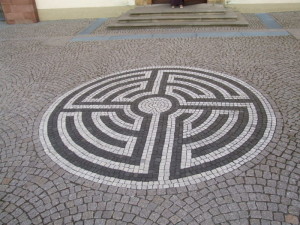 The difference between a maze and a labyrinth is that a maze has several paths and directions like a big puzzle, and a labyrinth is a single path that leads to the center. Large labyrinths can be very complex but if you look at them from the top down you will see there is a single path that eventually reaches the middle (as you see in the photos)
The difference between a maze and a labyrinth is that a maze has several paths and directions like a big puzzle, and a labyrinth is a single path that leads to the center. Large labyrinths can be very complex but if you look at them from the top down you will see there is a single path that eventually reaches the middle (as you see in the photos)
If you are lucky enough to live in an area that has a labyrinth close by, try a walking a labyrinth meditation. (The Labyrinth Society www.labyrinthsociety.org has a link to a labyrinth locator at http://labyrinthlocator.com)
This kind of meditation is great for people who find sitting meditations difficult because they fall asleep or get too restless.
Both of these meditations use one of the senses as a point of focus. Choose the one that best suits you. Or, experiment with using your sense of smell or touch as your focus.
Meditation using your sense of hearing
Walk at a relaxed pace.
As you walk, pay attention to everything you hear, without judgment. Imagine that the sound of birds twittering is no better than a lawn mower, just different. It is only a matter of perception that makes one sound seem better than another. Remind yourself to just listen and NOT judge what you hear.
As you walk, breath deeply and allow your shoulders to relax downward. If you sense any muscle tension take a few deep breaths as you walk. Focus on sensing that the air you breath is helping your muscles to relax.
If the sounds seem to be too distracting try switching your focus to one of the other senses for a few steps and notice how the sound seems to diminish as you change your focus. Either stay with your new focus as you complete your walking meditation or switch back to your sense of hearing.
Meditation using your sense of sight
As you walk at a comfortable pace, place your attention on what you see.
Really notice the colour, shape and texture of objects. Notice also your reaction to what you see. Do you have a physical reaction to what you see? For example a beautiful flower may elicit a deep inhale of satisfaction or the sight of a slug may give you a little shiver.
Rather than passing judgement on what you see, try to be impartial. Remind yourself you are just seeing, not judging. When thoughts and words come into your mind release them, bringing your focus back to just seeing the world around you.
According to Wikipedia.org – the cultural meaning of labyrinths
Prehistoric labyrinths are believed to have served as traps for malevolent spirits or as defined paths for ritual dances. In medieval times, the labyrinth symbolized a hard path to God with a clearly defined center (God) and one entrance (birth).
Labyrinths can be thought of as symbolic forms of pilgrimage; people can walk the path, ascending toward salvation or enlightenment. Many people could not afford to travel to holy sites and lands, so labyrinths and prayer substituted for such travel. Later, the religious significance of labyrinths faded, and they served primarily for entertainment, though recently their spiritual aspect has seen a resurgence.
Many newly made labyrinths exist today, in churches and parks. Labyrinths are used by modern mystics to help achieve a contemplative state. Walking among the turnings, one loses track of direction and of the outside world, and thus quiets the mind. The Labyrinth Society[34] provides a locator for modern labyrinths all over the world.
